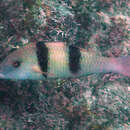en
names in breadcrumbs


Die Tweesaal-bokvis (Parupeneus trifasciatus) is 'n vis wat in die Indiese Oseaan, Oman en aan die ooskus van Afrika tot by die noorde van KwaZulu-Natal voorkom. In Engels staan die vis bekend as die Two-saddle goatfish.
Die vis word tot 30 cm lank. Die vis se kleur wissel van geelgrys tot dofrooi en daar is twee breë, swart vertikale strepe oor die lyf net onder die dorsale vinne. Hulle leef in rotskusareas en aflandige koraalriwwe in water wat tot 80 m diep is.
Die vis is gewoonlik 'n alleenloper maar kom ook in pare voor. Hulle verkies sanderige en rommelareas aangrensend aan die rif en vreet bodemskaaldiere, wurms en slakke.
Die Tweesaal-bokvis (Parupeneus trifasciatus) is 'n vis wat in die Indiese Oseaan, Oman en aan die ooskus van Afrika tot by die noorde van KwaZulu-Natal voorkom. In Engels staan die vis bekend as die Two-saddle goatfish.
Parupeneus trifasciatus és una espècie de peix de la família dels múl·lids i de l'ordre dels perciformes.
Els mascles poden assolir els 35 cm de longitud total.[2]
Es troba a l'Oceà Índic.[2]
Parupeneus trifasciatus és una espècie de peix de la família dels múl·lids i de l'ordre dels perciformes.
Parupeneus trifasciatus es una especie de peces de la familia Mullidae en el orden de los Perciformes.
• Los machos pueden llegar alcanzar los 35 cm de longitud total.[1]
Se encuentra en el Océano Índico.
Parupeneus trifasciatus es una especie de peces de la familia Mullidae en el orden de los Perciformes.
Parupeneus trifasciatus Parupeneus generoko animalia da. Arrainen barruko Mullidae familian sailkatzen da.
Parupeneus trifasciatus Parupeneus generoko animalia da. Arrainen barruko Mullidae familian sailkatzen da.
Parupeneus trifasciatus (Lacépède, 1801) è un pesce appartenente alla famiglia Mullidae[1].
Proviene dalle barriere coralline dell'oceano Indiano. Di solito vive nelle zone con fondali rocciosi, ricche di coralli, tra 1 e 80 m di profondità.
Il corpo è biancastro o grigio pallido, compresso sull'addome, con la testa scura e due fasce verticali dello stesso colore lungo il corpo. La pinna caudale è biforcuta; vicino alla bocca sono presenti dei barbigli. La lunghezza massima registrata è di 35 cm, anche se di solito non supera i 27.
Può formare banchi non particolarmente grandi.
Parupeneus trifasciatus is een straalvinnige vissensoort uit de familie van zeebarbelen (Mullidae).[1]
De wetenschappelijke naam van de soort is voor het eerst geldig gepubliceerd in 1801 door Bernard Germain de Lacépède.
Bronnen, noten en/of referenties二帶副緋鯉(学名:Parupeneus bifasciatus),又稱三帶副緋鯉,俗名秋姑、鬚哥,為輻鰭魚綱鱸形目鬚鯛科的一個種。
本魚分布於印度太平洋區,包括東非、紅海、波斯灣、亞丁灣、馬爾地夫、葛摩、模里西斯、塞席爾群島、印度、斯里蘭卡、馬來西亞、安達曼海、泰國、菲律賓、印尼、中國的南海、東海和台灣、日本、越南、新幾內亞、所羅門群島、澳洲、馬里亞納群島、馬紹爾群島、密克羅尼西亞、帛琉、諾魯、斐濟群島、東加、吉里巴斯、吐瓦魯、萬納杜、法屬波里尼西亞、墨西哥、加拉巴哥群島、厄瓜多等海域。属于热带和亚热带近岸底层鱼类。[1]
水深1~80公尺。
本魚體為黃色,腹部顏色較淡,體側具3條黑色寬橫帶,橫帶皆只達體側中央,它們分別在第一背鰭、第二背鰭下方及尾柄處。另其眼眶四周顏色較深,觸鬚黑褐色,尾鰭分叉,上下葉寬,背鰭兩個。背鰭硬棘共8枚、軟條共9枚;臀鰭硬棘1枚、軟條7枚。體長可達35公分。
本魚常可在礁湖或向海礁坡發現單獨或三五成群地活動。幼魚較常在礁台上游走,而成魚則在礁石外緣活動,屬肉食性,以多毛類、甲殼類為食。